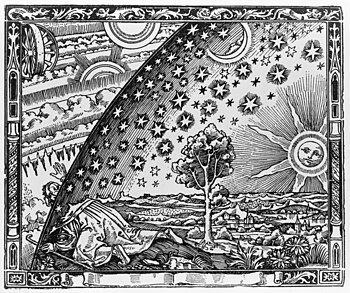Flammarion woodcut
From Wikipedia, the free encyclopedia
The Flammarion woodcut is an anonymous wood engraving (once thought to be a woodcut), so named because its first documented appearance is in Camille Flammarion's 1888 book L'atmosphère: météorologie populaire ("The Atmosphere: Popular Meteorology").[1]
Contents |
[edit] Description
The print depicts a man dressed as a medieval pilgrim and carrying a pilgrim's staff, peering through the sky as if it were a curtain to look at the hidden workings of the universe. One of the elements of the cosmic machinery bears a strong resemblance to traditional pictorial representations of the "wheel in the middle of a wheel" described in the visions of the prophet Ezekiel (see Merkabah). The caption in Flammarion's book translates as "A missionary of the Middle Ages tells that he had found the point where the sky and the Earth touched..." The image accompanies a text which reads, in part, "What, then, is this blue sky, which certainly does exist, and which veils from us the stars during the day? ... And yet this dome does not exist. In a balloon, I myself have risen higher than where the Greek gods were supposed to live without getting to this point, which of course disappears at the same rate in which we approach it."[2] The print is often described as being medieval due to its visual style, its fanciful vision of the world, and what appears to be a depiction of a flat Earth. It was, however, likely intended as an illustration that what the wanderer does in the picture cannot be possible, since there is no dome, nor is the Earth flat.
[edit] History
In 1957, astronomer Ernst Zinner claimed that the image dated to the German Renaissance, but he was unable to find any version published earlier than 1906.[3] Further investigation, however, revealed that the work was a composite of images characteristic of different historical periods, and that it had been made with a burin, the engraver's tool, used on wood for wood engraving only from the late 18th century. The image was traced to Flammarion's book by Arthur Beer, an astrophysicist and historian of German science at Cambridge and, independently, by Bruno Weber, the curator of rare books at the Zürich central library.[4]
According to Weber and to astronomer Joseph Ashbrook,[5] the depiction of a spherical heavenly vault separating the earth from an outer realm is similar to an illustration in Sebastian Münster's Cosmographia of 1544, a book which Flammarion, an ardent bibliophile and book collector, might have owned [1]. The idea of a pilgrim finding the place where the Earth and sky meet might have been inspired by a legend associated with Saint Macarius of Rome, a legend which Flammarion recounts in detail in his book Les mondes imaginaires et les mondes réels ("The Imaginary Worlds and the Real Worlds", 1865). Flammarion had been apprenticed at the age of twelve to an engraver in Paris and it is believed that many of the illustrations for his books were engraved from his own drawings, probably under his supervision. Therefore it is plausible that Flammarion himself created the image, though this has not been conclusively ascertained. There is no reason to believe that this earliest version was intended to be deceptive as to its date of creation.
The image was used as an illustration in C. G. Jung's "Flying Saucers: A Modern Myth of Things Seen in the Skies", published in 1959, and also as the cover illustrations for Daniel J. Boorstin's The Discoverers (1983), an account of the history of science and for The Mathematical Experience by Philip J. Davis and Reuben Hersh. The Flammarion woodcut has also been used in many other contexts to illustrate either the scientific or the mystical quests for knowledge.
[edit] See also
[edit] References
- ^ Flammarion, Camille (1888). L'atmosphère: météorologie populaire ("The Atmosphere: Popular Meteorology"). Paris. p. 163.
- ^ [http://www.georgpeez.de/texte/flamku.htm Quotation from "The atmosphere", p. 163]
- ^ E. Zinner, in Börsenblatt für den Deutschen Buchhandel, Frankfurt, 18 March 1957
- ^ B. Weber, in Gutenberg Jahrbuch, p. 381, 1973
- ^ J. Ashbrook, Sky & Telescope, p. 356, May 1977



